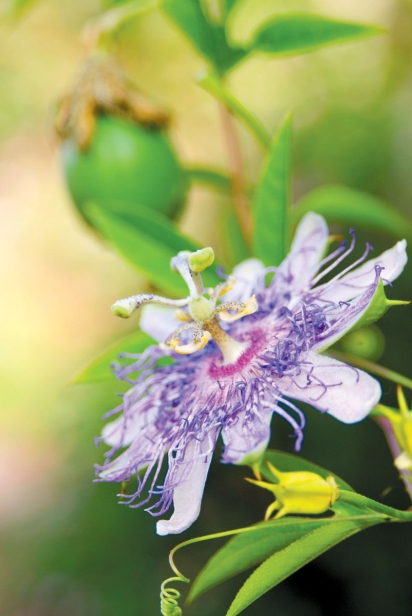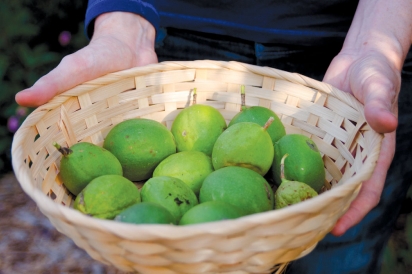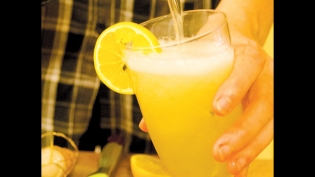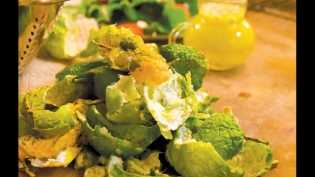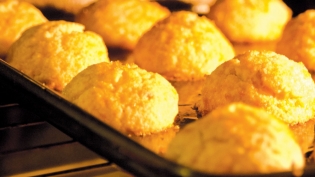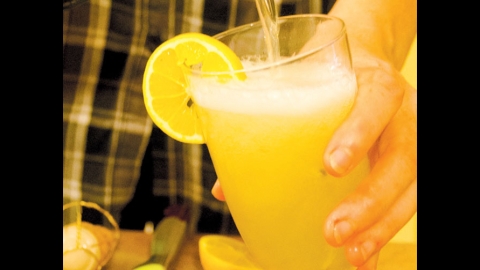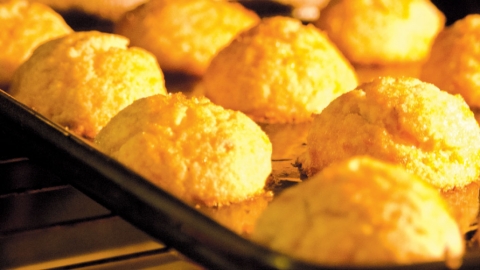Maypops For All
The Modern Hunter Gatherer
Plucking Our Native Passionfruit from Obscurity
I can’t figure out why everyone in the continental United States doesn’t know we have a native passionfruit. It should be in every produce section next to the bananas and in the freezer as a kid-favorite flavor of popsicle. Instead, if someone has even heard of it they tell me stories about throwing them at little siblings or busting the unripe, egg-sized green fruits against brick walls to hear them pop (one theory on their common name of “maypops,” the other is that they pop out of the ground in May). To be fair, I grew up making rotund green herds of cows by giving them twigs for legs—I had absolutely no clue I could eat them.
In 1621, William Stachey recorded in The Historie of Travaile Into Virginia Britannia, “Here is a fruict by the Naturalls called a Maracock, this groweth generally lowe and creepeth in a manner amongest the Corne (albeit I haue seene yt planted in a Gardein within our fort at James-towne, to spredd and rise as high as the Pale) yt is of the bignes of a Queene-apple, and hath many azurine or blew kernalls, like as a Pomegranett, and yt bloometh a most sweet and delicate flower, and yt is a good Sommer cooling fruict, and in every feild where the Indians plant their corne there be Cart-loades of them.”
When these same colonists pulled strawberries out of our forests and popularized them around the globe, why did everyone forget our apparent cartloads of delicious, easy to grow passionfruit?
Passiflora incarnata, aka “maypop,” is winter hardy to USDA zone 5 and can be found wild throughout the entirety of the Carolinas (plus west to Oklahoma, south to Florida, and north to at least Illinois). I dug up my colony from the forest edge behind the old Summit Drive Elementary School building the day before the bulldozers came. It’s been a decade since they rebuilt the school so that’s no longer a good place to look. Try local and online nurseries instead. Make sure that you are getting the correct species (Passiflora incarnata) and not one of the tropical or inedible Passiflora spp. To grow them from seed, make sure you are using fresh seeds that have never been dried—the embryos die if they aren’t kept moist. New plants can easily be grown from segments of maypop roots.
Our native passionfruits are green and smooth when unripe and turn yellowish and wrinkled when ready to eat (most kids pop them all long before they get to discover that phase). The insides of ripe maypops look and taste just like the purple, wrinkled Passiflora edulis fruits occasionally found in tropical fruit juice blends and specialty produce sections (usually in poor shape given how far they had to travel from their frost-free climates). A single ripe maypop is so aromatic and fully flavored that it can perfume an entire pitcher of tea or a batch of cake batter. I use the strained flesh interchangeably to vanilla extract and only add the seeds if I want some extra crunch; you can substitute maypop juice for the same quantity of any extract in a recipe. I usually scoop the pulp out with a spoon and rub it against a mesh strainer. Maypop passionfruits keep well on the counter and longer in the fridge, plus the pulp can be frozen for later use.
If you can’t grow them yourself, it shouldn’t be hard to talk a gardener friend into it. Passionflowers are arguably the showiest, most deliciously fragrant flowers in the floral kingdom. For butterfly enthusiasts, its leaves are the caterpillar food plant of both the monarch-like gulf fritillary and the stripey zebra longwing. They have another distinct insect relationship with carpenter bees, which fit like Cinderella’s slipper to pollinate maypop blooms. This may seem like a downside for people who dislike the destructive chewing of carpenter bees, but maypops also happen to be partially carnivorous. When the bees show up, the flower nectar gets them too drunk to leave. After pollination, the bees fall to the ground where they die and break down into fertilizer for the sneaky vine. I rarely see any honeybees or other beloved pollinators on my passionflower blooms, so I don’t tend to mind this sinister side effect that turns house-munching bees into delicious fruit.
I’m not the only one who has noticed this phenomena. Herbalists use the soporific effects of the plant for insomnia and anxiety (though I never understood drinking a tea to make me sleepy since it just means I’ll have to get back out of bed in an hour). Historians, naturalists and botanists have been name-dropping maypops for centuries (again, why aren’t they a modern fruit sensation?) Back in 1853, Francis Channing Woodworth recorded in his Wonders of the Insect World, with Illustrative Engravings,
“I regret exceedingly to be obliged to announce the fact, that bumble bees are sometimes given to tippling. It seems that the nectar in the passion flower has an intoxicating effect upon these creatures, and that they now and then indulge in excessive drinking, when this beverage is within their reach. Instead of being content with a moderate drought, like orderly and temperate bees, they yield to temptation, and drink until they are quite drunk. They become so stupid, indeed, from their intemperate drinking, that they scarcely can fly home to their nest; and it sometimes happens, that one may see half a dozen of these poor creatures lying on the ground, near the goblet which has so grossly intoxicated them, and entirely unable to stir an inch. The dunces! They are almost as silly as the human drunkards that we too frequently meet with.”
I’ll take a guess that you wouldn’t catch old Mr. Woodworth tippling some maypop mimosas (recipe in sidebar) and that’s his loss. My husband and I also highly recommend a simple infusion of passionfruit pulp in a mason jar of vodka—in a day or two you have a delicious passionfruit liquor for cocktails or sipping over ice. Plus, it stores virtually forever. Don’t worry, no one will beat you to harvesting the ripe maypops out of the ditch (except perhaps those darned kids); they don’t even know what they are.
Sources for Maypops
(Passiflora incarnata):
Bountiful Gardens
Willits, CA
707-459-6410
bountiful@sonic.net
www.bountifulgardens.org
Logee’s
Danielson, CT
888-330-8038
info@logees.net
www.logees.com



